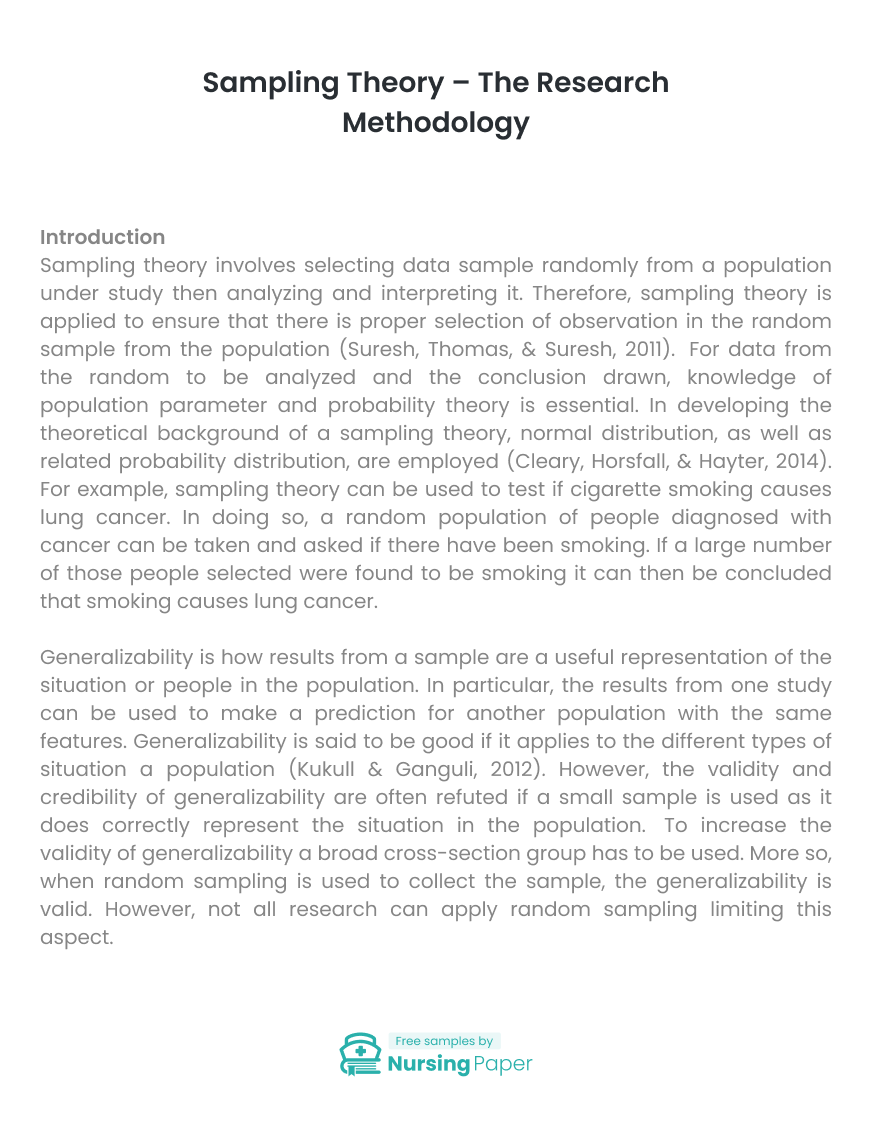
Introduction
Sampling theory involves selecting data sample randomly from a population under study then analyzing and interpreting it. Therefore, sampling theory is applied to ensure that there is proper selection of observation in the random sample from the population (Suresh, Thomas, & Suresh, 2011). For data from the random to be analyzed and the conclusion drawn, knowledge of population parameter and probability theory is essential. In developing the theoretical background of a sampling theory, normal distribution, as well as related probability distribution, are employed (Cleary, Horsfall, & Hayter, 2014). For example, sampling theory can be used to test if cigarette smoking causes lung cancer. In doing so, a random population of people diagnosed with cancer can be taken and asked if there have been smoking. If a large number of those people selected were found to be smoking it can then be concluded that smoking causes lung cancer.
Generalizability is how results from a sample are a useful representation of the situation or people in the population. In particular, the results from one study can be used to make a prediction for another population with the same features. Generalizability is said to be good if it applies to the different types of situation a population (Kukull & Ganguli, 2012). However, the validity and credibility of generalizability are often refuted if a small sample is used as it does correctly represent the situation in the population. To increase the validity of generalizability a broad cross-section group has to be used. More so, when random sampling is used to collect the sample, the generalizability is valid. However, not all research can apply random sampling limiting this aspect. Making use of inclusion and exclusion criteria which shows the population on which these results apply to becomes necessary in this type of research (Kukull & Ganguli, 2012).


1. Cleary, M., Horsfall, J., & Hayter, M. (2014). Data collection and sampling in qualitative research: does size matter?. Journal of advanced nursing, 70(3), 473-475.
2. Kukull, W. A., & Ganguli, M. (2012). Generalizability The trees, the forest, and the low-hanging fruit. Neurology, 78(23), 1886-1891.
3. Suresh, K., Thomas, S. V., & Suresh, G. (2011). Design, data analysis and sampling techniques for clinical research. Annals of Indian Academy of Neurology, 14(4), 287.



The download will start shortly.

The download will start shortly.
 Subject:
Medicine
Subject:
Medicine  Number of pages: 2
Number of pages: 2  Subject:
Health and Social Care
Subject:
Health and Social Care  Number of pages: 8
Number of pages: 8  Subject:
Medicine
Subject:
Medicine  Number of pages: 4
Number of pages: 4  Subject:
Medicine
Subject:
Medicine  Number of pages: 5
Number of pages: 5  Subject:
Medicine
Subject:
Medicine  Number of pages: 4
Number of pages: 4  Subject:
Health and Social Care
Subject:
Health and Social Care  Number of pages: 3
Number of pages: 3  Subject:
Nursing
Subject:
Nursing  Number of pages: 2
Number of pages: 2  Subject:
Medicine
Subject:
Medicine  Number of pages: 3
Number of pages: 3  Subject:
Health and Social Care
Subject:
Health and Social Care  Number of pages: 4
Number of pages: 4  Subject:
Medicine
Subject:
Medicine  Number of pages: 3
Number of pages: 3  Subject:
Nursing
Subject:
Nursing  Number of pages: 4
Number of pages: 4  Subject:
Nursing
Subject:
Nursing  Number of pages: 11
Number of pages: 11  Subject:
Nursing
Subject:
Nursing  Number of pages: 8
Number of pages: 8  Subject:
Medicine
Subject:
Medicine  Number of pages: 7
Number of pages: 7  Subject:
Health and Social Care
Subject:
Health and Social Care  Number of pages: 2
Number of pages: 2 
